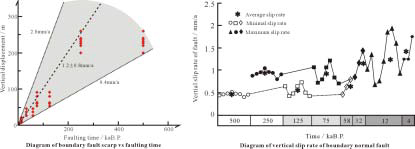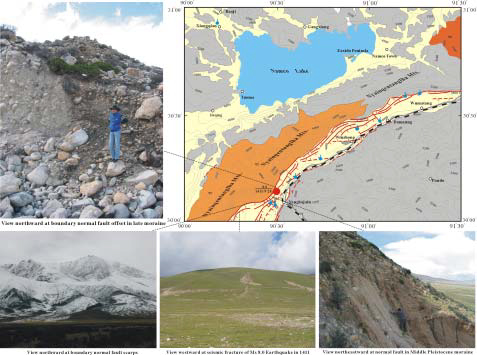Golmud-Lhasa Railway Geological Survey
SLIP-RATE AND HOLOCENE SEISMIC FRACTURES OF THE DAMXUNG-YANGBAJAIN ACTIVE FAULT
The Damxung-Yangbajain active fault is located in northwest boundary of Damxung-Yangbajain graben in the south Lhasa block of the southeast Piedmont normal fault system of Nyainqentanglha Mts. (Fig.14). It generally trends at northeast, but tends to an E-W trend in some segments in the northern Damxung basin. It controls earthquakes, seismic fractures and high-temperature thermal fields, where cluster of hotsprings and sinters formed (Wu et al., 2004). The Damxung-Yangbajain active fault system is consists of en-echelon normal faults along the northwest boundary of Damxung-Yangbajain graben. The system is characterized by fault scarps, fault cliffs, stream offsets and old seismic features such as scarps, fractures, pressure ridges, sag ponds and pull-apart basins formed in Quaternary. The vertical slip rate is estimated as 0.4mm/a~2mm/a in Late Cenozoic, 1.1±0.3mm/a in Quaternary and 1.4±0.6mm/a in Holocene in general and 3~5mm/a at some localities (Fig.13). Some minor faults of NE and NW trends formed in the Ningzhong, Ladaogang and Yangbajain basins where they control evolution of geothermal fields and the distribution of high temperature hotsprings.

Fig.13 Vertical offsets and slip rates of Damxung-Yangbajain fault in southeast of Nyainqentanglha Mts.
The Ms 8.0 Yangbajain earthquake occurred in 1411 with epicenter in the western Yangbajain basin, where it formed scarps and fractures along the west boundary faults of the Jiadaguo depression and Yangbajain, Ningzhong and Damxung basins. The Ms 7.5 Jiuzila earthquake occurred in 1952 formed fractures along the north boundary fault of the Damxung basin. In fact seismic activity is so intense that at least 4 earthquakes of Ms 7.5-8.0 occurred during the Holocene at intervals of 2300±700a. These formed widespread seismic features in the southeast piedmont of the Nyainqentanglha Mts. along the northwest boundary fault of the Damxung-Yangbajain graben.

Fig.14 Map of Quaternary geology and active faults of Damxung-Yangbajain graben
(Explanation: isoline marks elevation of summit and basin /m)




